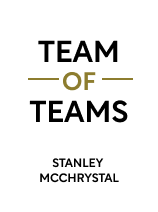

This article is an excerpt from the Shortform book guide to "Team of Teams" by Stanley McChrystal. Shortform has the world's best summaries and analyses of books you should be reading.
Like this article? Sign up for a free trial here .
What is the Team of Teams book about? What was the role of General Stanley McChrystal in helping the U.S. task force counteract Al Qaeda and capture Zarqawi?
Team of Teams is a book that tells the true story of how General Stanley McChrystal transformed the U.S. task force in the middle of the war with Al Qaeda. He did this by cutting down the length of its chain of command to speed up decision-making and increase team agility.
Keep reading for more about Team of Teams book by General Stanley McChrystal.
Team of Teams: Book Overview
In 2004 in Iraq, the U.S. Joint Special Operations Task Force was struggling to counter Al Qaeda, which was spreading sectarian discord and violence to undermine the shaky Iraqi government.
The U.S. task force—consisting of elite special forces teams, strategists, and analysts from every branch of the U.S. military—was charged with disrupting Al Qaeda in Iraq (AQI) by conducting raids, gathering intelligence, and killing or capturing terrorist leaders. However, despite its enormous resources and expertise, the task force soon found its conventional approach—based on a rigid command structure and lengthy centralized planning processes—failing for two reasons:
1) They faced a new type of enemy. The huge, slow-moving task force couldn’t keep up with AQI, which functioned as a decentralized network of agile teams that could strike quickly, reconfigure immediately, and integrate their actions globally.
2) They faced a new type of environment. Iraq was a complex environment far different from what the military organized and trained for—it was characterized by rapid, unpredictable events, rather than events that military organizers could foresee and plan for.
In addition, the technology of global connectedness allowed terrorists to operate in radically different ways. It meant AQI leader Abu Musab al Zarqawi could build an effective organization despite having few resources. Through bomb-making videos and online propaganda, AQI incited sectarian conflict in Iraq. Further, the ability to transmit information instantly and widely gave AQI enormous influence among disaffected people and enabled it to constantly expand.
When General Stanley McChrystal took command of the task force, he realized that to counter the chaos that AQI nurtured and thrived on, the task force needed a dynamic approach to fit the dynamic enemy and environment.
The first step was to overcome what the military refers to as its limfac, or its limiting factor—the biggest element hindering success. The task force’s limiting factor was its inflexible structure or organizational model. McChrystal set out to transform the task force into a “team of teams” that functioned on a huge scale with the agility and effectiveness demonstrated by its small, elite commando teams in individual missions.
In his book Team of Teams, McChrystal shares the story of how he restructured the US task force by cutting down the length of its chain of command. Drawing on both military history and management theory, McChrystal suggests that the task force’s experiences in reinventing itself can apply to many organizations facing unconventional challenges.

———End of Preview———
Like what you just read? Read the rest of the world's best book summary and analysis of Stanley McChrystal's "Team of Teams" at Shortform .
Here's what you'll find in our full Team of Teams summary :
- How General Stanley McChrystal transformed the U.S. Joint Special Operations Task Force
- What teams that operate well can offer to an organization
- How the team of teams organizational model helped bring down a major Al Qaeda leader






